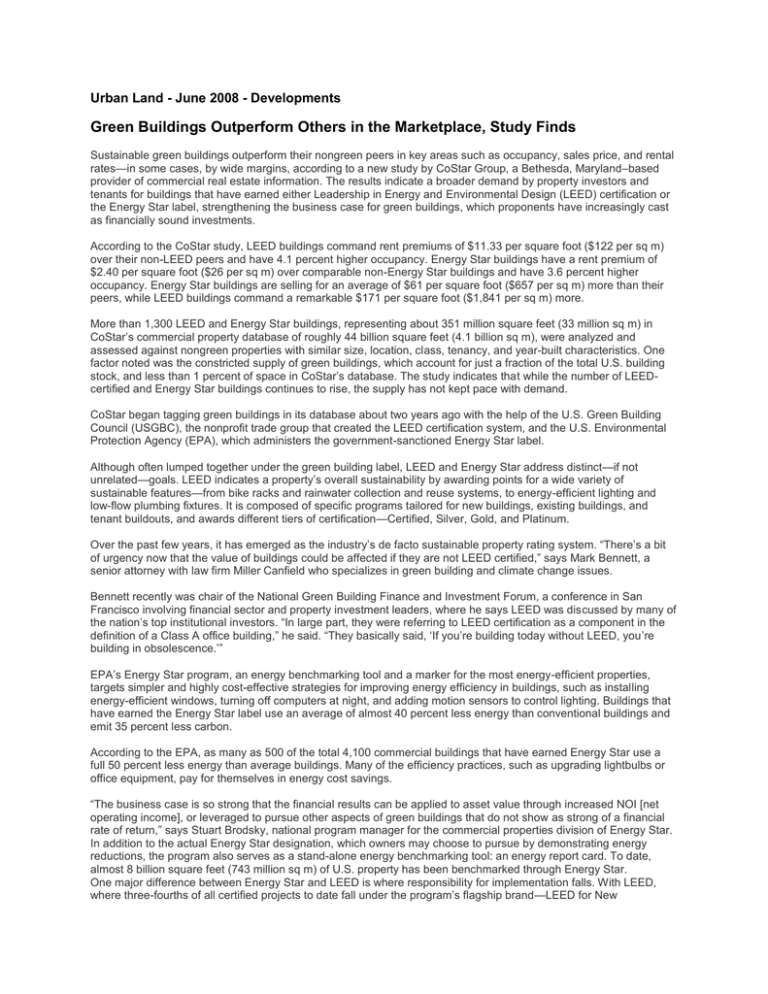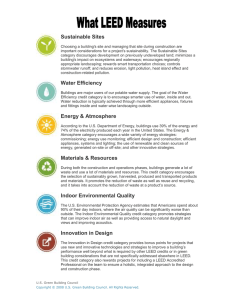
Urban Land - June 2008 - Developments
Green Buildings Outperform Others in the Marketplace, Study Finds
Sustainable green buildings outperform their nongreen peers in key areas such as occupancy, sales price, and rental
rates—in some cases, by wide margins, according to a new study by CoStar Group, a Bethesda, Maryland–based
provider of commercial real estate information. The results indicate a broader demand by property investors and
tenants for buildings that have earned either Leadership in Energy and Environmental Design (LEED) certification or
the Energy Star label, strengthening the business case for green buildings, which proponents have increasingly cast
as financially sound investments.
According to the CoStar study, LEED buildings command rent premiums of $11.33 per square foot ($122 per sq m)
over their non-LEED peers and have 4.1 percent higher occupancy. Energy Star buildings have a rent premium of
$2.40 per square foot ($26 per sq m) over comparable non-Energy Star buildings and have 3.6 percent higher
occupancy. Energy Star buildings are selling for an average of $61 per square foot ($657 per sq m) more than their
peers, while LEED buildings command a remarkable $171 per square foot ($1,841 per sq m) more.
More than 1,300 LEED and Energy Star buildings, representing about 351 million square feet (33 million sq m) in
CoStar’s commercial property database of roughly 44 billion square feet (4.1 billion sq m), were analyzed and
assessed against nongreen properties with similar size, location, class, tenancy, and year-built characteristics. One
factor noted was the constricted supply of green buildings, which account for just a fraction of the total U.S. building
stock, and less than 1 percent of space in CoStar’s database. The study indicates that while the number of LEEDcertified and Energy Star buildings continues to rise, the supply has not kept pace with demand.
CoStar began tagging green buildings in its database about two years ago with the help of the U.S. Green Building
Council (USGBC), the nonprofit trade group that created the LEED certification system, and the U.S. Environmental
Protection Agency (EPA), which administers the government-sanctioned Energy Star label.
Although often lumped together under the green building label, LEED and Energy Star address distinct—if not
unrelated—goals. LEED indicates a property’s overall sustainability by awarding points for a wide variety of
sustainable features—from bike racks and rainwater collection and reuse systems, to energy-efficient lighting and
low-flow plumbing fixtures. It is composed of specific programs tailored for new buildings, existing buildings, and
tenant buildouts, and awards different tiers of certification—Certified, Silver, Gold, and Platinum.
Over the past few years, it has emerged as the industry’s de facto sustainable property rating system. “There’s a bit
of urgency now that the value of buildings could be affected if they are not LEED certified,” says Mark Bennett, a
senior attorney with law firm Miller Canfield who specializes in green building and climate change issues.
Bennett recently was chair of the National Green Building Finance and Investment Forum, a conference in San
Francisco involving financial sector and property investment leaders, where he says LEED was discussed by many of
the nation’s top institutional investors. “In large part, they were referring to LEED certification as a component in the
definition of a Class A office building,” he said. “They basically said, ‘If you’re building today without LEED, you’re
building in obsolescence.’”
EPA’s Energy Star program, an energy benchmarking tool and a marker for the most energy-efficient properties,
targets simpler and highly cost-effective strategies for improving energy efficiency in buildings, such as installing
energy-efficient windows, turning off computers at night, and adding motion sensors to control lighting. Buildings that
have earned the Energy Star label use an average of almost 40 percent less energy than conventional buildings and
emit 35 percent less carbon.
According to the EPA, as many as 500 of the total 4,100 commercial buildings that have earned Energy Star use a
full 50 percent less energy than average buildings. Many of the efficiency practices, such as upgrading lightbulbs or
office equipment, pay for themselves in energy cost savings.
“The business case is so strong that the financial results can be applied to asset value through increased NOI [net
operating income], or leveraged to pursue other aspects of green buildings that do not show as strong of a financial
rate of return,” says Stuart Brodsky, national program manager for the commercial properties division of Energy Star.
In addition to the actual Energy Star designation, which owners may choose to pursue by demonstrating energy
reductions, the program also serves as a stand-alone energy benchmarking tool: an energy report card. To date,
almost 8 billion square feet (743 million sq m) of U.S. property has been benchmarked through Energy Star.
One major difference between Energy Star and LEED is where responsibility for implementation falls. With LEED,
where three-fourths of all certified projects to date fall under the program’s flagship brand—LEED for New
Construction (LEED-NC)—the burden for certification is largely on architects and engineers at the design stage. In
the case of Energy Star, which looks exclusively at energy consumption in existing assets, responsibility shifts to
property managers.
Energy Star is often seen as just one piece of the sustainability puzzle, while LEED buildings, especially those
certified under LEED-NC, do not always correlate to high levels of energy efficiency. (USGBC has recently retooled
its building operations platform, LEED for Existing Buildings [LEED-EB]). The differences between the two programs
have benefited both programs, allowing them to serve the same customers without becoming direct competitors.
Urban Land: June 2008
© 2008 ULI–the Urban Land Institute, all rights reserved.





